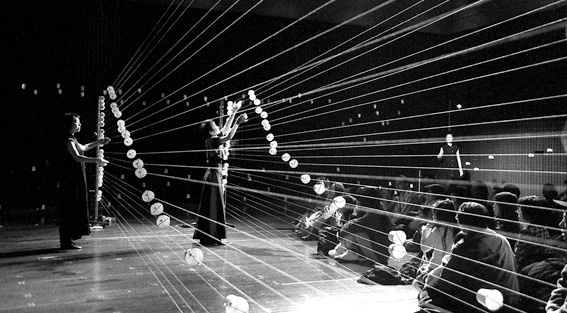by Brett Iimura and Iona Macnab
What does playing ‘telephone’ with paper cups and string have to do with making music?
Everything when it comes to Kazue Mizushima’s innovative performance group, Stringraphy. If you are looking for a unique and fascinating glimpse into modern Japanese cultural expression, look no further. Stringraphy performances offer children and adults alike an entrancing musical experience. Imagine walking into a room filled with dozens of strings, strung tautly between support poles two meters high and running in slightly differing directions the entire length of the room. Paper cups dot all of the strings as if the room were set up for an international children’s paper-cup-telephone Skyping session. You take a seat on a cushion on the floor or on a stool between some of the rows of strings. The lights dim and five forms flit into the room, taking their positions at various points among the strings. The music begins as the women, in their originally designed thematically colored costumes, flow between the sets of strings and around each other, reaching up and kneeling down, all the while plucking melodies that fill the entire room with sound. It is an other worldly sensation.
Close your eyes. If it is a classical European piece you will be amazed at how it sounds as if a whole orchestra is playing before you. An environmental piece will have you feeling as if you are sitting in the middle of the woods listening to the sounds of various birds chirping, insects buzzing, or wind rustling through the leaves. Contemporary music will have you clapping to the beat, and popular songs will have you singing along, while some of the originally composed avant garde pieces may, admittedly, have you feeling as if nails are being drawn down a blackboard.
The instrument, itself a work of art, is designed individually and specifically for each performance to make full use of the visual and acoustic dynamics of each particular venue, as well as to fit the selection of music to be played. It consists of three sets of strings: soprano, alto, and bass, each set consisting of more than a dozen silk strings strung tightly between support poles as far apart as 15 meters, depending upon the size of the space. These can be tuned to major or minor keys depending on the pieces being played. Additional strings are added at times for special effect sounds. Ms. Mizushima, the inventor of the instrument, originally referred to it simply as the ‘string telephone instrument’ while she was developing it in the early 1990s. As the ensemble’s highly visual performance style evolved, she renamed it to include both the material it is made from, string, and the visual art ‘graphics’ aspect it encompasses. The installation of the instrument is complex and delicate, with each string requiring fine tuning determined by its length, thickness, and tautness.
The paper cups act as amplifiers, broadcasting the sound in all directions. The performers pluck and slide their gloved hands along the strings, eliciting an amazing range of sounds. Rather than watching an orchestra or band sit or stand in more or less the same place throughout a concert, the eyes are also treated to a visually pleasing and entrancing dance out of which the music appears to flow. Children and adults alike sit transfixed within the magical world created.

Internationally popular, performances to date have taken place in theaters, museums, schools, and even outdoors. Schools are particularly attracted to it because of its ability to incorporate science (how sound travels) and the arts. Small, one-string instruments can easily be constructed to give audience members a chance to pluck a simple do-re-mi scale, make a bird sing, or try a rendition of Twinkle, Twinkle Little Star out for themselves. Studio Eve, the ensemble’s home-base, is a smaller, one-room space in which concerts and workshops are held throughout the year. They are also available for private parties, schools, and events. This year’s fall line-up is a wonderful chance for the whole family to enjoy Stringraphy’s unique visual-music performances.
Brett Iimura ICCE, mother of two, is the director of the Childbirth Education Center (CEC), serving parents-to-be throughout Japan since 1997. Iona Macnab IBCLC is a lactation consultant in private practice in Tokyo and a mother of three.
They have over thirty years of combined experience in Japan, and much experience raising bilingual, bicultural children!
Parenting Tip:
The Stringraphy studio’s fall lineup is as follows: September 25, 7:30pm and September 26, 6pm, 70-minute performance. Adults:1,500, children through junior high school age: 1,000. This will be an adult-oriented program featuring an original piece entitled A Fall Evening. There will also be a special 45-minute, child-friendly concert/workshop three times this fall on September 26, October 24, and November 28.
There will be two performances a day at 10am and 2pm. Children up to six years old: 500, elementary school students to adults: 1,000 (children up to six are free and elementary aged kids are 500 if Setagayaku residents, please bring proof of residency).
For reservations, a map to the studio, and more information, call 03-5376-3633,
email [email protected], or check www.stringraphy.com.









